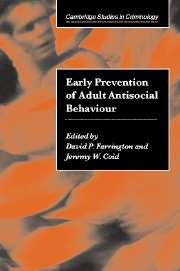Book contents
- Frontmatter
- Contents
- List of figures
- List of tables
- List of contributors
- Preface
- 1 Advancing knowledge about the early prevention of adult antisocial behaviour
- 2 Formulating strategies for the primary prevention of adult antisocial behaviour: “High risk” or ‘population’ strategies?
- 3 Risk factors for adult antisocial personality
- 4 Preventing the intergenerational continuity of antisocial behaviour: Implications of partner violence
- 5 Protective factors and resilience
- 6 Prevention during pregnancy, infancy and the preschool years
- 7 Prevention through family and parenting programmes
- 8 Prevention in the school years
- 9 Prevention of antisocial behaviour in females
- 10 Economic costs and benefits of primary prevention of delinquency and later offending: A review of the research
- 11 Conclusions and the way forward
- Index
- References
1 - Advancing knowledge about the early prevention of adult antisocial behaviour
Published online by Cambridge University Press: 22 September 2009
- Frontmatter
- Contents
- List of figures
- List of tables
- List of contributors
- Preface
- 1 Advancing knowledge about the early prevention of adult antisocial behaviour
- 2 Formulating strategies for the primary prevention of adult antisocial behaviour: “High risk” or ‘population’ strategies?
- 3 Risk factors for adult antisocial personality
- 4 Preventing the intergenerational continuity of antisocial behaviour: Implications of partner violence
- 5 Protective factors and resilience
- 6 Prevention during pregnancy, infancy and the preschool years
- 7 Prevention through family and parenting programmes
- 8 Prevention in the school years
- 9 Prevention of antisocial behaviour in females
- 10 Economic costs and benefits of primary prevention of delinquency and later offending: A review of the research
- 11 Conclusions and the way forward
- Index
- References
Summary
The main aims of this book are to review what is known about the causes and prevention of adult antisocial behaviour. The book aims to specify what we know, what we do not know, and what we need to know, recommending priority research that would address key questions and fill key gaps in knowledge. The main aim of this introductory chapter is to set the scene for the more detailed chapters that follow by outlining some of the key topics, issues and questions arising in the early prevention of adult antisocial behaviour. This chapter defines the territory by briefly reviewing epidemiology, development, risk and protective factors, and prevention programmes.
Four types of prevention can be distinguished (Tonry and Farrington, 1995). Criminal justice prevention refers to traditional deterrence, incapacitation and rehabilitation strategies operated by law enforcement and criminal justice agencies. Situational prevention refers to interventions designed to reduce the opportunities for antisocial behaviour and to increase the risk and difficulty of committing antisocial acts. Community prevention refers to interventions designed to change the social conditions and social institutions (e.g. community norms and organisations) that influence antisocial behaviour in communities. Developmental prevention refers to interventions designed to inhibit the development of antisocial behaviour in individuals, by targeting risk and protective factors that influence human development (see Farrington, 2000a).
This book concentrates on early developmental prevention programmes, including those implemented in pregnancy and infancy, parenting programmes, preschool programmes, individual skills training, and school programmes.
- Type
- Chapter
- Information
- Early Prevention of Adult Antisocial Behaviour , pp. 1 - 31Publisher: Cambridge University PressPrint publication year: 2003
References
- 6
- Cited by



